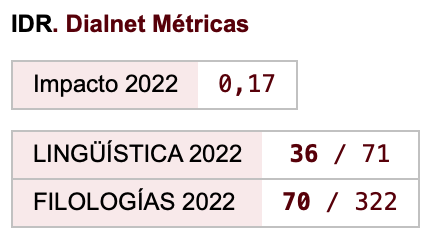Spanish students' perceptions of the creation of a course for the communication degree course
Keywords:
linguistic motivations, Spanish for the professions, qualitative and quantitative methods, curriculum, HoustonAbstract
El siguiente estudio describe las percepciones de los estudiantes de cursos de español como lengua extranjera sobre la creación de cursos de español con fines específicos (EFE) o español para las profesiones, específicamente para la carrera de comunicación en la Universidad de Houston en los Estados Unidos. Con el uso de métodos cualitativos y cualitativos se entrevistaron 60 estudiantes del área de comunicación para reconocer el interés de los participantes en un curso enfocado en su carrera y sobre los contenidos de este. Los resultados mostraron que un 88 % de los participants están interesados en tomar cursos de EFE porque lo ven como una necesidad en la ciudad de Houston y en Los Estados Unidos. Dentro de sus motivaciones principales están: mejorar oportunidades de trabajo, obtener créditos para su carrera y comunicarse con hispanos en la ciudad. Con respecto al contenido del curso, los encuestados afirmaron que desean recibir un vocabulario enfocado en lo que estudian, conocer los detalles culturales relacionados con la carrera y tener acceso a ejercicios donde mejoren sus habilidades interpersonales.
Downloads
References
Abbot, A. & Lear, D. (2010) ‘Marketing business Languages: Teaching students to value and promote their coursework”, Global Business Languages: Vol. 15, Article 2. Disponible en: http//docs.lib.purdue.edu/gbl/vol15/iss1/2
Alonso, C. (2006) "Spanish: The foreign national language." ADFL Bulletin 37.2-3: 15-15-20. Linguistics and Language Behavior Abstracts (LLBA).
Beaudrie, S., Ducar, C., & Relaño-Pastor, A.M. (2009).Curricular perspectives in the heritage language context: Assessing culture and identity. Language, Culture and Curriculum, 22 (2), 157-174.
Beaudrie, S. & Fairclough, M. (2012). Spanish as a heritage language in the United States: The state of the field. Washington, DC: Georgetown University Press.
Belcher, D. (2006). “English for specific purposes: Teaching to perceived needs and imagined futures in worlds of work, study, and everyday life.” TESOL Quarterly 40 (1): 133–56.
Chia, H.U., Johnson, R., Chia, H.L., & Olive, F. (1999). English for college students in Taiwan: A study of perceptions of English needs in a medical context. English for Specific Purposes, 18(2), 107–119.
https://doi.org/10.1016/S0889-4906(97)00052-5
Gardner, R. (1985) Social psychology and second language learning: The role of attitudes and motivation. London: Edward Arnold.
Gómez, J. (2001). La enseñanza: Aprendizaje del español con fines específicos. Madrid: Ed. Edinumen.
Pheils, P. B., & Naledi, M. S. (2009) Communicating with Latino patients. Journal of Nursing Education. September 2009;48(9):515-518. Available from: CINAHL Plus with Full Text, Ipswich, MA.
Grose, C. U., & Voght, G. (1991). The evolution of languages for specific purposes in the United States. The Modern Language Journal. 75, 181-195.
Lafford, B.; Abbot, A., & Lear, D. (2014) Spanish in the professions and in the community in the US, Journal of Spanish Language Teaching, 1:2, 171 186, DOI: 10.1080/23247797.2014.970361.
Lear, D. (2005). Spanish for working medical professionals: Linguistic needs. Foreign Language Annals 38: 223-235.
Long, M. K. (2017). Introduction: LSP studies and the creation of translingual and transcultural competence. Language for specific purposes: Trends in curriculum development, Georgetown University Press, Washington, D.C., 2017, pp. 112. JSTOR, www.jstor.org/stable/j.ctt1ps3169.6.
Long, M. K., & Uscinski, I. (2012). Evolution of languages for specific purposes programs in the United States: 1990-2011. Modern Language Journal, 96, 173-189.
Silva-Corvalán, C., & Enrique-Arias, A. (2001). Sociolingüística y pragmática del español. Washington, D.C: Georgetown University Press.
Upton, T. A. (2012). “LSP at 50: Looking Back, Looking Forward.” Iberica 23: 9–28.
Van Lier, L. (2004). The ecology and semiotics of language learning. New York: Kluwer Academic.
Vargas Blanco, E. M. (2018). Actitudes lingüísticas de padres y madres en familias colombianas y mexicanas en Houston: un estudio cualitativo. Forma y Función, [S.l.], v. 31, n.1, p. 155-181, ene. 2018. ISSN 2256-5464 Disponible en: https://revistas.unal.edu.co/index.php/formayfuncion/article/view/70446/64990
Vendryes, J. (1929). Le langage. Introduction linguistique a l’histoire. Paris: La Renaissance.
Downloads
Published
How to Cite
Issue
Section
License
Authors who publish with this journal agree to the following terms:
- Authors retain copyright and grant the journal right of first publication with the work simultaneously licensed under a Creative Commons Attribution License that allows others to share the work with an acknowledgement of the work's authorship and initial publication in this journal.
- Authors are able to enter into separate, additional contractual arrangements for the non-exclusive distribution of the journal's published version of the work (e.g., post it to an institutional repository or publish it in a book), with an acknowledgement of its initial publication in this journal.
- Authors are permitted and encouraged to post their work online (e.g., in institutional repositories or on their website) prior to and during the submission process, as it can lead to productive exchanges, as well as earlier and greater citation of published work (See The Effect of Open Access).

Revista de Lenguas para fines específicos is licensed under a Creative Commons Reconocimiento-NoComercial-SinObraDerivada 4.0 Internacional License.
























